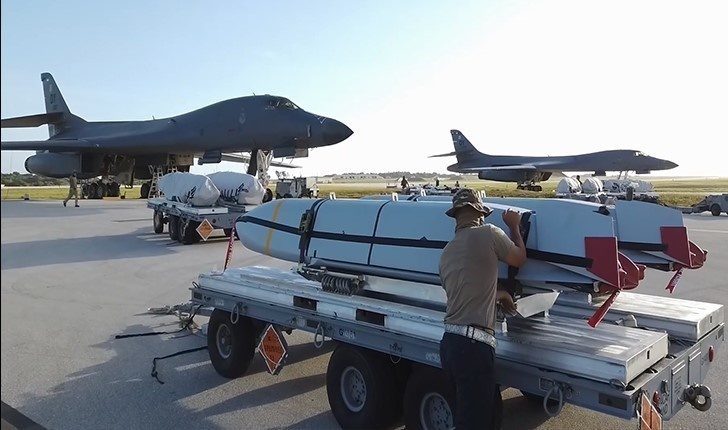JASSM is a joint USAF-Navy autonomous, precision cruise missile for use against heavily defended or high-value targets at standoff range.
It can attack fixed, relocatable, and moderately hardened/buried targets. The base-variant is a stealthy, low-cost airframe equipped with GPS/INS guidance and imaging IR terminal seeker.
The JASSM-Extended Range (JASSM-ER) version uses the same baseline body, but a new engine and fuel system that increase range to more than 500 miles. The ER was cleared for combat on the B-1B in 2015, reached full operational capability on the F-15E in 2018, and is planned for use on all fighter/bomber platforms. Full-rate production began in 2018, and production shifted to ER-only in 2016.
Further development has resulted in the extended range AGM-158B and “extreme range” AGM-158D, which is retargetable via data link after launch. JASSM-ER production is shifting to AGM-158B-2 and production of the jam-resistant B-3 is projected for 2026. Prior production JASSM will not be upgraded though USAF aims to modify existing contract lots to procure B-2/B-3 instead. The AGM-158D is also currently in development and planned for delivery starting in 2027.
Lockheed Martin is further developing the Long-Range Anti-Ship Missile (LRASM), which reached early operational capability on the B-1B in December 2018 and is planned for fielding on the B-52.
USAF conducted a proof-of-concept employing palletized JASSM from mobility aircraft in 2020 in a massed standoff attack. JASSM and LRASM are USAF’s premiere weapons for use in a high-end threat scenario. Notable efforts include Weapon Data Link (WDL) development to enable post-launch retargeting and precision guidance for GPS-denied environments.
The service increased its JASSM stockpile objective by 47 percent, and FY25 funds continue maximum-rate procurement of 550 JASSM-ER as well as continuing LRASM purchases of 115 weapons. The manufacturer is opening a second production facility to double JASSM/LRASM production, and USAF plans to increase purchases to 810 missiles a year due to threats in Europe and the Pacific.
A B-2A successfully launched JASSM-ER for the first time during an integration test flight in 2022, and an F-15EX conducted its first shot as part of integrated testing in August 2023. Both the F-35B and C variants began flight testing this past year to carry JASSM/LRASM externally as part of Block 4 upgrades.
AGM-158 JASSM Technical Data
Contractors: Lockheed Martin; Raytheon; Honeywell.
First Flight: April 8, 1999.
Delivered: 2001-present.
IOC: September 2003; December 2014 (ER variant); 2018 (LRASM).
Production: 10,000 JASSM (planned); 400 LRASM (planned).
Active Variants: •AGM-158A JASSM. Base-variant. •AGM-158B JASSM-ER. Extended-range variant. •AGM-158C LRASM. Long-Range Anti-Ship Missile, based on JASSM. •AGM-158D JASSM-ER. Developmental extreme-range variant of JASSM-ER (previously XR).
Dimensions: Length 14 ft, diameter approx. 2 ft, wingspan 7.8 ft
Power Plant: Teledyne Technologies J402 turbojet (JASSM); Williams Intl. F107-WR-105 turbofan (JASSM-ER).
Performance: Speed subsonic, range 200+ miles (baseline), 500+ miles (ER), approx. 1000 miles (XR).
Guidance: GPS/INS and imaging IR terminal seeker.
Warhead: 1,000-lb class penetrator (JASSM); 1,000-lb blast fragmentation (LRASM).
Integration: B-1B, B-2, B-52H, F-15E, and F-16 Block 40-52; planned: F35A (JASSM). B-1B, B-2A, B-52H, F-15E F-16; planned: F-35A (JASSM-ER B1B; planned: B-52 (LRASM).


